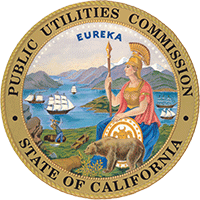Agency Inspection Process and Indicators
The Gas Safety and Reliability Branch’s (GSRB) goal is to ensure the safety of pipeline systems to protect people, property, and the environment.
What is an inspection?
An inspection is an on-site evaluation of an inspection unit (an operating area such as a specific city or metropolitan area, or a group of towns, etc.) for compliance with applicable Federal or State gas safety standards. This includes a thorough compliance review of the operator’s plans, procedures, programs, records, physical plant(s), works in progress, and LNG facilities. Most inspections will involve both a records inspection (examination of an operator’s programs and procedures) and a field inspection (on-site inspection at various facilities).
CPUC conducts several different types of inspections at minimum intervals specified by PHMSA’s Guidelines for State Programs.
What are the different types of inspections and how often are they conducted?
Once every 5 years:
- Procedures review
- Operation, maintenance, and emergency plan
- Transmission Integrity Management Program
- Distribution Integrity Management Program
- Public Awareness Program
- Damage Prevention Program
- Drug and Alcohol program
- Operator Qualification Program, etc.
Once every 3 years:
- LNG
Continuous:
- Construction Projects
What safety criteria would prompt additional oversight?
CPUC investigates incidents triggered by leaks, ruptures, or other safety events. A incident investigation will involve an on-site inspection of damage, interviews and data analysis. The CPUC will try to uncover the root cause and measures to prevent recurrence. In addition, CPUC investigations will identify any systematic failures or operator negligence.
CPUC may consider increasing an inspection interval (more frequent inspections) based on several leading and lagging indicators, as specified below.
Leading indicators (Proactive measures)
- Pipeline Integrity Management (managing pipeline safety throughout its life cycle by conducting risk assessment and threat identification including pressure testing)
- Safety Related Conditions (leading indicator of a proactive safety culture)
- Public Awareness Program
- Self-identified and self-corrected violations
- Cathodic protection of steel pipe
Lagging indicators (Reactive measures) to measure safety performance based on historical incident data and safety violations.
- Pipeline size, age and material
- Serious incident rate: Tracking the number of significant incidents per mile of pipeline, and their causes, provides a direct measure of past safety performance. The significant incidents include injuries, fatalities, property damage, service interruption, under pressure events, etc.
- Location - High consequence area (HCA): Total number of miles of pipelines installed in HCAs.
- Excavation damage rates: This metric tracks the frequency of pipeline damage caused by digging, a major cause of incidents.
- Leak causes: For gas transmission and distribution systems, these indicators include the total number and types of leaks reported and the total number of hazardous leaks reported per mile.
- Inspection and Investigation findings: Violations, concerns, and prompt corrective actions
- Population density (class location), Environmental and Social Justice (ESJ) Communities, and environmental sensitivity
More information on Inspection Schedule
- GSRB website provides public access to inspection schedules and updates, categorized by geographic area and inspection type. Infrastructure Safety Inspection Schedule
